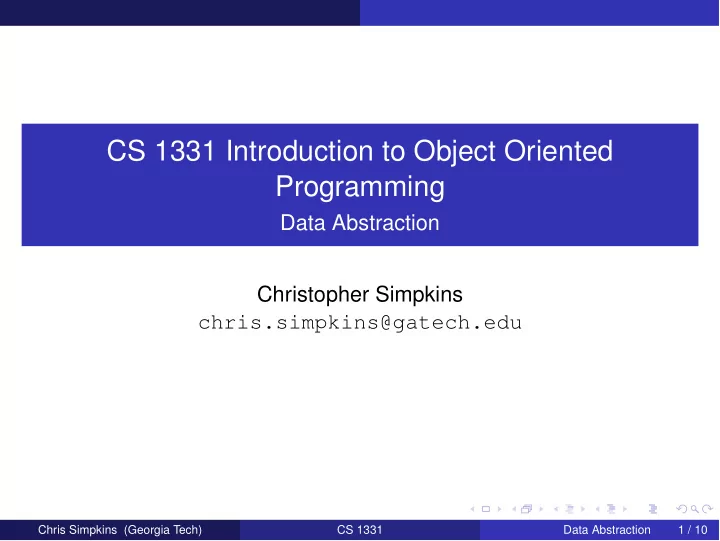

CS 1331 Introduction to Object Oriented Programming Data Abstraction Christopher Simpkins chris.simpkins@gatech.edu Chris Simpkins (Georgia Tech) CS 1331 Data Abstraction 1 / 10
Data Abstraction An abstraction of a concept attempts to capture the essence of the concept – its essential properties and behaviors – by ignoring irrelevant details. Process abstraction - group the operations of a process in a subprogram and expose only the essential elements of the process to clients through the subprogram signature (e.g., function/method name and parameters) Data abstraction - encapsulation of data with the operations defined on the data A particular data abstraction is called an abstract data type . Note that ADT’s include process abstractions as well In each case, an abstraction hides details — details of a process or details of a data structure. “Abstraction is selective ignorance.” – Andrew Koenig (C++ Guru) Chris Simpkins (Georgia Tech) CS 1331 Data Abstraction 2 / 10
A Complex Number ADT ADT: Complex Data: real: double the real part of a complex number imaginary: double the imaginary part of a complex number Operations: new - construct a new complex number plus - add one complex number to another, yielding a new complex number An ADT is abstract becuase the data and operations of the ADT are defined independently of how they are implemented. We say that an ADT encapsulates the data and the operations on the data. Chris Simpkins (Georgia Tech) CS 1331 Data Abstraction 3 / 10
Data Abstractions with Classes Java provides langauge suppport for defining ADTs in the form of classes. A class is a blueprint for objects. A class definition contains instance variables, a.k.a. member variables or fields – the state, or data of an object methods, a.k.a. member functions or messages – the operations defined on objects of the class We instantiate or construct an object from a class. Chris Simpkins (Georgia Tech) CS 1331 Data Abstraction 4 / 10
Java Implementation of Complex Number ADT Here’s a Java implementation of our complex number ADT 1 : public class Complex { // These are the data of the ADT private double real; private double imaginary; // These are the operations of the ADT public Complex(double aReal, double anImaginary) { real = aReal; imaginary = anImaginary; } public Complex plus(Complex other) { double resultReal = this.real + other.real; double resultImaginary = this.imaginary + other.imaginary; return new Complex(resultReal, resultImaginary); } } 1 http://introcs.cs.princeton.edu/java/33design/ Chris Simpkins (Georgia Tech) CS 1331 Data Abstraction 5 / 10
Reference Variables Consider the following code: Complex a = new Complex(1.0, 2.0); Complex b = new Complex(3.0, 4.0); Complex c = a.plus(b); a , b , and c are reference variables of type Complex . Reference variables have one of two values: the address of an object in memory (in this case an instance of Complex ), or null , meaning the variable references nothing. Chris Simpkins (Georgia Tech) CS 1331 Data Abstraction 6 / 10
Invoking Constructors The line: Complex a = new Complex(1.0, 2.0); invokes the Complex constructor, passing arguments 1.0 and 2.0 : public Complex(aReal= 1.0 , anImaginary= 2.0 ) { real = 1.0 ; imaginary = 2.0 ; } which instantiates a Complex object and stores its address in the variable a : Complex a = new Complex(1.0, 2.0); Constructors initialize objects. After the line above, Complex object a ’s instance variables have the values 1.0 and 2.0 . Chris Simpkins (Georgia Tech) CS 1331 Data Abstraction 7 / 10
Visualizing Objects and Instantiation The object creation expression new Complex(1.0, 2.0) applies the Complex blueprint defined by the class definition from slide 5: to the constructor arguments (1.0, 2.0) to create an instance of Complex : We can assign this object to a reference variable, e.g., Complex a = new Complex(1.0, 2.0) : Chris Simpkins (Georgia Tech) CS 1331 Data Abstraction 8 / 10
Invoking Methods on Objects The line: Complex c = a.plus(b); invokes the plus method on the a object, passing the b object as an argument, which binds the object referenced by b to the parameter other : a.plus(other= b ) { double resultReal = this.real + b .real; // 1.0 + 3.0 double resultImaginary = this.imaginary + b .imaginary; // 2.0 + 4.0 return new Complex(resultReal, resultImaginary); } which returns a new Complex object and assigns its address to the reference variable c . Chris Simpkins (Georgia Tech) CS 1331 Data Abstraction 9 / 10
Using the Complex Class Users, or clients of the Complex class can then write code like this: Complex a = new Complex(1.0, 2.0); Complex b = new Complex(3.0, 4.0); Complex c = a.plus(b); without being concerned with Complex ’s implementation (which could use polar form, for example). Clients (i.e., users) of the Complex class need only be concerned with its interface, or API (application programmer interface) – the public methods of the class. After the code above we have the following Complex objects in memory: Chris Simpkins (Georgia Tech) CS 1331 Data Abstraction 10 / 10
Recommend
More recommend